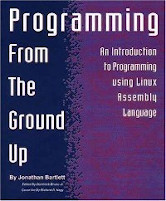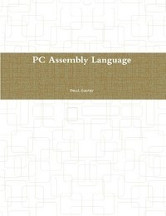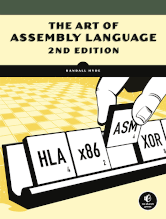Last Updated on May 22, 2022
An assembly language is a low-level programming language for a computer, or other programmable device. Assembly language is used by almost all modern desktop and laptop computers. It is as close to writing machine code without writing in pure hexadecimal. It is converted into executable machine code by a utility program referred to as an assembler.
Assembly language is infrequently used by programmers nowadays, but there are still good reasons to learn the language. It is the most powerful computer programming language available. While assembly language shares very little with high level languages (such as Java, C#, Python etc), and assembly languages for different CPU architectures often have little in common, it gives programmers the insight required to write effective code in high-level languages.
Assembly language is also used primarily for direct hardware manipulation, access to specialized processor instructions, or to address critical performance issues. Assembly is excellent for speed optimization.
1. Programming from the Ground Up by Jonathan Bartlett
 Programming from the Ground Up is an introductory book to programming and computer science using assembly language. It teaches assembly language for x86 processors and Linux. It assumes the reader has never programmed before, and introduces the concepts of variables, functions, and flow control.
Programming from the Ground Up is an introductory book to programming and computer science using assembly language. It teaches assembly language for x86 processors and Linux. It assumes the reader has never programmed before, and introduces the concepts of variables, functions, and flow control.
The reason for using assembly language is to get the reader thinking in terms of how the computer actually works underneath. Knowing how the computer works from a “bare-metal” standpoint is often the difference between top-level programmers and programmers who can never quite master their art.
This book should teach the reader to understand how a program works and interacts with other programs, be able to read programmers’ code and learn how they work, to learn new programming languages quickly, and also to learn advanced concept in computer science quickly. The book includes review exercises at the end of each chapter.
Chapters cover:
- Introduction.
- Computer Architecture – structure of computer memory, the CPU, interpreting memory, and data accessing methods.
- Your First Programs – teaches the reader the process for writing and building Linux assembly-language programs, the structure of assembly-language programs, and a few assembly-language commands.
- All About Functions – looks at how functions work, assembly-language functions using the C calling convention, and recursive functions.
- Dealing with Files – the UNIX file concept, buffers and .bss, standard and special files, and using files in a program.
- Reading and Writing Simple Records – deals with reading and writing simple fixed-length records.
- Developing Robust Programs – deals with developing programs that handle error conditions gracefully. This is known as robust programs.
- Sharing Functions with Code Libraries – using a shared library, how shared libraries work, finding information about libraries, useful functions, and building a shared library.
- Intermediate Memory Topics – how a computer views memory, the memory layout of a Linux program, getting more memory, a simple memory manager, and more.
- Counting Like a Computer.
- High Level Languages – looks at a “real-world” programming language.
- Optimization – focuses on speed optimization.
- Moving on from Here.
- Appendices.
Permission is granted to copy, distribute and/or modify the book under the terms of the GNU Free Documentation License, Version 1.1 or any later version published by the Free Software Foundation.
2. Reverse Engineering for Beginners by Dennis Yurichev
 Reverse Engineering for Beginners offers a primer on reverse-engineering, delving into disassembly code-level reverse engineering and explaining how to decipher assembly language for those beginners who would like to learn to understand x86 (which accounts for almost all executable software in the world) and ARM code created by C/C++ compilers. It discusses x86/x64, ARM/ARM64, MIPS, and Java/JVM.
Reverse Engineering for Beginners offers a primer on reverse-engineering, delving into disassembly code-level reverse engineering and explaining how to decipher assembly language for those beginners who would like to learn to understand x86 (which accounts for almost all executable software in the world) and ARM code created by C/C++ compilers. It discusses x86/x64, ARM/ARM64, MIPS, and Java/JVM.
Chapters cover:
- Code patterns – Hello, world!, Stack, printf(), scanf(), accessing passed arguments, pointers, GOTO, conditional jumps, switch()/case/default, loops, floating-point unit, arrays, manipulating specific bit(s), structures, unions, pointers to functions, 64-bit values in 32-bit environment, and more.
- Important fundamentals – endianness, memory, and CPU.
- Slightly more advance examples – temperature converting, Fibonacci numbers, iterators, Duff’s device, inline functions, variadic functions, strings trimming, obfuscation, C++, and more.
- Finding important/interesting stuff in the code – strings, constants, suspicious code patterns, and more.
- OS-specific – arguments passing methods, thread local storage – system calls, Linux, and more.
- Tools.
- Examples of reversing proprietary file formats.
The book is available in Russian and English, and there are partial translations in Chinese, German, French, Italian, and Brazilian Portuguese.
This work is licensed under the Creative Commons Attribution-ShareAlike 4.0 International (CC BY-SA 4.0) license.
3. PC Assembly Language by Paul Carter

PC Assembly Language offers a good tutorial on 32-bit protected mode assembly programming on the x86 processor.
The tutorial has extensive coverage of interfacing assembly and C code and so will interest C programmers who want to learn about how C works under the hood.
All the examples use the free NASM (Netwide) assembler.
Chapters cover:
- Introduction – number systems, computer organization, assembly language, and creating a program.
- Basic Assembly Language – explains how to work with integers, control structures, translating standard control structures. The chapter also looks at a program that finds prime numbers.
- Bit Operations – shift operations, Boolean bitwise operations, avoiding conditional branches, manipulating bits in C, big and little endian representations, and counting bits.
- Subprograms – looks at using subprograms to make modular programs and to interface with high level languages.
- Arrays – defining arrays, and array/string instructions.
- Floating Point – floating point representation, floating point arithmetic, the numeric coprocessor.
- Structures and C++.
The book may be reproduced and distributed in its entirety, provided that no charge is made for the document itself, without the author’s consent.
4. The Art of Assembly Language Programming by Randall Hyde
 The Art of Assembly Language Programming (AoA), Randy Hyde’s acclaimed text on assembly language programming, is the most-often recommended book on 80×86 assembly language programming in newsgroups, on web sites, and by word of mouth.
The Art of Assembly Language Programming (AoA), Randy Hyde’s acclaimed text on assembly language programming, is the most-often recommended book on 80×86 assembly language programming in newsgroups, on web sites, and by word of mouth.
AoA teaches the fundamentals one must know to be considered an assembly language programmer, and AoA was written by a recognized expert in x86 assembly language programming.
There are 4 different editions available.
Next page: Page 2 – x86-64 Assembly Language Programming with Ubuntu and more books
Pages in this article:
Page 1 – Programming from the Ground Up and more books
Page 2 – x86-64 Assembly Language Programming with Ubuntu and more books
All books in this series:
| Free Programming Books | |
|---|---|
| Ada | ALGOL-like programming language, extended from Pascal and other languages |
| Agda | Dependently typed functional language based on intuitionistic Type Theory |
| Arduino | Inexpensive, flexible, open source microcontroller platform |
| Assembly | As close to writing machine code without writing in pure hexadecimal |
| Awk | Versatile language designed for pattern scanning and processing language |
| Bash | Shell and command language; popular both as a shell and a scripting language |
| BASIC | Beginner’s All-purpose Symbolic Instruction Code |
| C | General-purpose, procedural, portable, high-level language |
| C++ | General-purpose, portable, free-form, multi-paradigm language |
| C# | Combines the power and flexibility of C++ with the simplicity of Visual Basic |
| Clojure | Dialect of the Lisp programming language |
| ClojureScript | Compiler for Clojure that targets JavaScript |
| COBOL | Common Business-Oriented Language |
| CoffeeScript | Transcompiles into JavaScript inspired by Ruby, Python and Haskell |
| Coq | Dependently typed language similar to Agda, Idris, F* and others |
| Crystal | General-purpose, concurrent, multi-paradigm, object-oriented language |
| CSS | CSS (Cascading Style Sheets) specifies a web page’s appearance |
| D | General-purpose systems programming language with a C-like syntax |
| Dart | Client-optimized language for fast apps on multiple platforms |
| Dylan | Multi-paradigm language supporting functional and object-oriented coding |
| ECMAScript | Best known as the language embedded in web browsers |
| Eiffel | Object-oriented language designed by Bertrand Meyer |
| Elixir | Relatively new functional language running on the Erlang virtual machine |
| Erlang | General-purpose, concurrent, declarative, functional language |
| F# | Uses functional, imperative, and object-oriented programming methods |
| Factor | Dynamic stack-based programming language |
| Forth | Imperative stack-based programming language |
| Fortran | The first high-level language, using the first compiler |
| Go | Compiled, statically typed programming language |
| Groovy | Powerful, optionally typed and dynamic language |
| Haskell | Standardized, general-purpose, polymorphically, statically typed language |
| HTML | HyperText Markup Language |
| Icon | Wide variety of features for processing and presenting symbolic data |
| J | Array programming language based primarily on APL |
| Java | General-purpose, concurrent, class-based, object-oriented, high-level language |
| JavaScript | Interpreted, prototype-based, scripting language |
| Julia | High-level, high-performance language for technical computing |
| Kotlin | More modern version of Java |
| LabVIEW | Designed to enable domain experts to build power systems quickly |
| LaTeX | Professional document preparation system and document markup language |
| Lisp | Unique features - excellent to study programming constructs |
| Logo | Dialect of Lisp that features interactivity, modularity, extensibility |
| Lua | Designed as an embeddable scripting language |
| Markdown | Plain text formatting syntax designed to be easy-to-read and easy-to-write |
| Objective-C | Object-oriented language that adds Smalltalk-style messaging to C |
| OCaml | The main implementation of the Caml language |
| Pascal | Imperative and procedural language designed in the late 1960s |
| Perl | High-level, general-purpose, interpreted, scripting, dynamic language |
| PHP | PHP has been at the helm of the web for many years |
| PostScript | Interpreted, stack-based and Turing complete language |
| Prolog | A general purpose, declarative, logic programming language |
| PureScript | Small strongly, statically typed language compiling to JavaScript |
| Python | General-purpose, structured, powerful language |
| QML | Hierarchical declarative language for user interface layout - JSON-like syntax |
| R | De facto standard among statisticians and data analysts |
| Racket | General-purpose, object-oriented, multi-paradigm, functional language |
| Raku | Member of the Perl family of programming languages |
| Ruby | General purpose, scripting, structured, flexible, fully object-oriented language |
| Rust | Ideal for systems, embedded, and other performance critical code |
| Scala | Modern, object-functional, multi-paradigm, Java-based language |
| Scheme | A general-purpose, functional language descended from Lisp and Algol |
| Scratch | Visual programming language designed for 8-16 year-old children |
| SQL | Access and manipulate data held in a relational database management system |
| Standard ML | General-purpose functional language characterized as "Lisp with types" |
| Swift | Powerful and intuitive general-purpose programming language |
| Tcl | Dynamic language based on concepts of Lisp, C, and Unix shells |
| TeX | Markup and programming language - create professional quality typeset text |
| TypeScript | Strict syntactical superset of JavaScript adding optional static typing |
| Vala | Object-oriented language, syntactically similar to C# |
| VHDL | Hardware description language used in electronic design automation |
| VimL | Powerful scripting language of the Vim editor |
| XML | Rules for defining semantic tags describing structure ad meaning |
